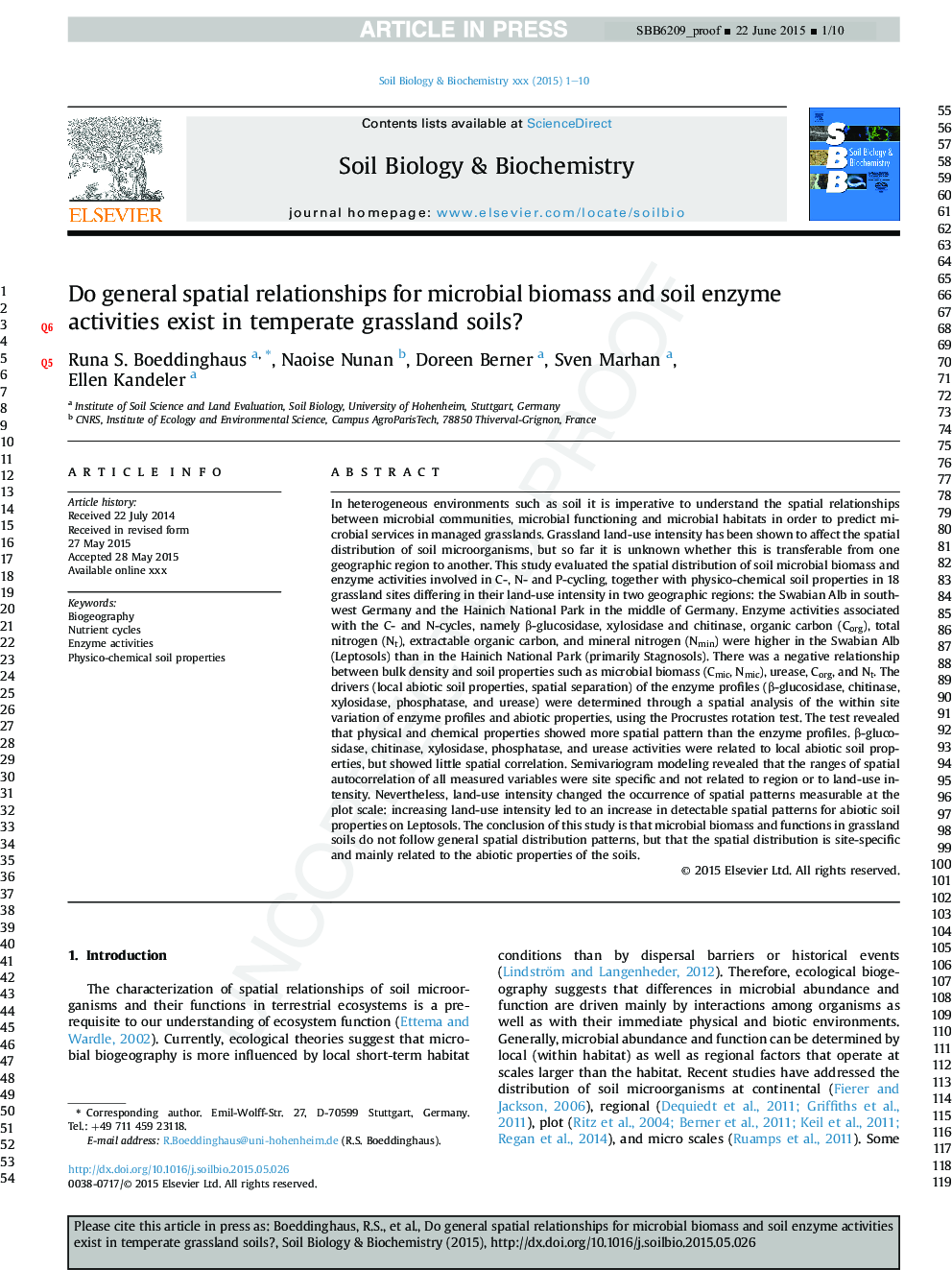| کد مقاله | کد نشریه | سال انتشار | مقاله انگلیسی | نسخه تمام متن |
|---|---|---|---|---|
| 8364109 | 1542596 | 2015 | 10 صفحه PDF | دانلود رایگان |
عنوان انگلیسی مقاله ISI
Do general spatial relationships for microbial biomass and soil enzyme activities exist in temperate grassland soils?
ترجمه فارسی عنوان
آیا روابط عمومی فضایی برای بیوماس میکروبی و فعالیت آنزیم خاک وجود دارد در خاک های علفزار معتدل؟
دانلود مقاله + سفارش ترجمه
دانلود مقاله ISI انگلیسی
رایگان برای ایرانیان
کلمات کلیدی
بیوگرافی چرخه های تغذیه ای، فعالیت های آنزیم، خواص فیزیکی و شیمیایی خاک،
موضوعات مرتبط
علوم زیستی و بیوفناوری
علوم کشاورزی و بیولوژیک
دانش خاک شناسی
چکیده انگلیسی
In heterogeneous environments such as soil it is imperative to understand the spatial relationships between microbial communities, microbial functioning and microbial habitats in order to predict microbial services in managed grasslands. Grassland land-use intensity has been shown to affect the spatial distribution of soil microorganisms, but so far it is unknown whether this is transferable from one geographic region to another. This study evaluated the spatial distribution of soil microbial biomass and enzyme activities involved in C-, N- and P-cycling, together with physico-chemical soil properties in 18 grassland sites differing in their land-use intensity in two geographic regions: the Hainich National Park in the middle of Germany and the Swabian Alb in south-west Germany. Enzyme activities associated with the C- and N-cycles, namely β-glucosidase, xylosidase and chitinase, organic carbon (Corg), total nitrogen (Nt), extractable organic carbon, and mineral nitrogen (Nmin) were higher in the Swabian Alb (Leptosols) than in the Hainich National Park (primarily Stagnosols). There was a negative relationship between bulk density and soil properties such as microbial biomass (Cmic, Nmic), urease, Corg, and Nt. The drivers (local abiotic soil properties, spatial separation) of the enzyme profiles (β-glucosidase, chitinase, xylosidase, phosphatase, and urease) were determined through a spatial analysis of the within site variation of enzyme profiles and abiotic properties, using the Procrustes rotation test. The test revealed that physical and chemical properties showed more spatial pattern than the enzyme profiles. β-glucosidase, chitinase, xylosidase, phosphatase, and urease activities were related to local abiotic soil properties, but showed little spatial correlation. Semivariogram modeling revealed that the ranges of spatial autocorrelation of all measured variables were site specific and not related to region or to land-use intensity. Nevertheless, land-use intensity changed the occurrence of spatial patterns measurable at the plot scale: increasing land-use intensity led to an increase in detectable spatial patterns for abiotic soil properties on Leptosols. The conclusion of this study is that microbial biomass and functions in grassland soils do not follow general spatial distribution patterns, but that the spatial distribution is site-specific and mainly related to the abiotic properties of the soils.
ناشر
Database: Elsevier - ScienceDirect (ساینس دایرکت)
Journal: Soil Biology and Biochemistry - Volume 88, September 2015, Pages 430-440
Journal: Soil Biology and Biochemistry - Volume 88, September 2015, Pages 430-440
نویسندگان
Runa S. Boeddinghaus, Naoise Nunan, Doreen Berner, Sven Marhan, Ellen Kandeler,
